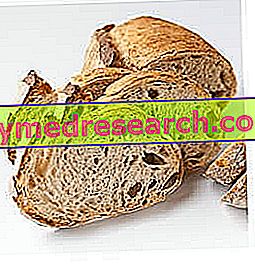Generality
The mother yeast is a leavening agent for bakery products, INDISPENSABLE to the packaging of many traditional foods. Other synonyms for sourdough are: sourdough, sourdough and natural yeast.

The mother yeast is not simple to make and use, since it needs to be kept alive and refreshed; on the other hand, it enriches the foods in which it is incorporated, thanks to the greater biodiversity of the biological starters it contains. This favors some nutritional transformations that ENRICH the finished product.
Mother Yeast: a Live Food
The mother yeast could be defined as a " mixture of wheat flour and water left to ferment spontaneously, or without the inoculation of new fermentative microbes ". Obviously, this does not mean that (thanks to modern technologies) the "first sourdough" cannot be obtained by selecting the desired biological starters. The aforesaid definition, rather, indicates that the sourdough DOES NOT require, after the creation, further additions of yeasts or bacteria; it is in fact sufficient that, periodically and systematically, the micro-organisms already present in it are fed.
The mother yeast is therefore a VIVO food that must be preserved in respect of the bacteria and the fungi that compose it. It is combined with water and flour, obtaining a mixture from which, after a long leavening, it will retain a part (about 1/3 or 1/2) destined for the next use. The mother yeast is maintained thanks to a sort of "perpetual motion" and could be defined as an inexhaustible yeast!
At this point, many readers will ask WHAT are the differences between the use of brewer's yeast and that of mother yeast; the answer is decidedly complex and articulated but, first of all, it is essential to underline the discrepancy between the microbial flora of the two products. While the brewer's yeast is made up exclusively (or almost) of Saccharomyces yeasts (mainly cerevisiae ), the mother yeast has a greater variety of active microorganisms among which, in addition to the yeasts ( Saccharomyces and Candida), there are some LACTIC or mofermentating bacteria ( or that they produce only lactic acid and carbon dioxide) and and terofermentants (that is, they also produce secondary compounds such as acetic acid, ethanol, etc.); among the latter we mention:
- Lactobacillus : L. plantarum, L. casei and L. brevis
- Leuconostoc : L. mesenteroides
- Pediococcus : L. pentosaceus
etc.
These bacteria, also producing lactic and acetic acid, determine "the acidification of the paste" and are responsible for various nutritional, organoleptic and gustatory modifications of the product obtained with the yeast. Based on some surveys carried out on the bread crumbs obtained with sourdough. concentrations of acetic acid were found up to 20 times higher than those of the food obtained by direct leavening with brewer's yeast.
Nutritional Food Changes through Mother Yeast
All the processes of transformation by micro-organisms (bread-making, yogurt acidification, fermentation of beer, wine, gherkins, sauerkraut, etc.) modify the chemistry and therefore the nutritional intake of the food. However, these processes are different based on the type of biological starter, the initial substrate and the degree of proliferation.
While the yeast strain contained in brewer's yeast produces substantially carbon dioxide and water, the variety present in the yeast is responsible for many additional alterations.
First of all, as anticipated, the mother yeast (thanks to the presence of bacteria) involves the release of lactic acid, acetic acid and ethanol. These, which in part are dispersed in cooking, are nevertheless noticeable in the final bouquet of the food. It should be emphasized that, at times, the presence of acetic acid can be perceived as a pungent odor and not always pleasant; however, the excess of this molecule is a prerogative of the "young" mother yeast, used a few times and which therefore still has to "balance".
Secondly, in the yeast there is a greater protein hydrolysis, with the production of short peptides and free amino acids; this is made possible also by the long and indispensable leavening times. This characteristic makes the food produced with yeast more digestible and susceptible to the Maillard reaction with cooking (to the advantage of appearance and aroma).
The same micro-organisms, again thanks to the long leavening times, more effectively degrade the anti-nutritional molecules and release certain mineral salts. Moreover, in the bacterial processes it is frequent to dispense certain water-soluble vitamins of group B which greatly enrich the finished food (even if, by means of cooking, part of it is destroyed).
Last but not least, the chemical composition of the bacteria and the yeasts themselves. These, which exploit the organic substrates grow and multiply, become an integral part of the food. This is a rather neglected aspect but still noteworthy; in the table below the chemical profiles of some microorganisms are summarized (taken from: Food dictionary. Science and technique ).

Do you think you know all the secrets of the yeast ?
Take the quiz and test your knowledge!
Production
Theoretical Video
Watch the video
X Watch the video on youtubePractical Video: how to make sourdough at home
Mother Yeast - Properties and Home Preparation
X Problems with video playback? Reload from YouTube Go to Video Page Go to Video Recipes Section Watch the video on youtubePractical Video: BREAD WITH YEAST MOTHER MADE IN THE HOME
Homemade Yeast Bread
X Problems with video playback? Reload from YouTube Go to Video Page Go to Video Recipes Section Watch the video on youtubeExample of preparation of sourdough . PHASE 1) To obtain a new acid paste it is first of all necessary to produce a mixture of water and flour, left in contact with the air in order to enrich the yeasts present in the environment.
Mix the ingredients and knead until the mixture is soft. Make a cross cut and let it rest in a glass container covered with a clean and damp cloth, at room temperature for 48 hours (during which it will double in volume). PHASE 2 (3rd-4th day). After 48 hours of rest, take a part of the mixture (eg 200 grams) and add it:
Mix the ingredients and knead until the mixture is soft. Then let it sit for 48 hours in the same way as for phase 1. PHASE 3 (5th-6th day). After 48 hours of rest, repeat step 2. STAGE 4 (7th -13th day). After 48 hours of rest, repeat step 3 but leave to rest only for 24 hours. Repeat every 24 hours for another 7 days. STEP 5 (14th day). After two weeks from the start of phase 1, the sourdough will be ready. If the preparation is too acidic, extend phase 4 for a few more days. Once obtained, the sourdough is stored in the refrigerator and kept alive and reproduced by means of subsequent refreshments every 2/6 days. |
Refresh operation example . The evening before preparation, take the sourdough from the fridge. Let it rest at least 15 minutes at room temperature and add flour and warm water in the proportions of:
Knead and let it rest at room temperature for at least one night. The next day:
|
The sourdough is ALWAYS different; between one geographical area and another, or even just between one room and another (for environmental reasons), different microbiological proliferations are obtained and this significantly changes the final product; even, in the same yeast, at a distance of years but even more in the first weeks, there is a real change in the balance between yeasts and bacteria.
To obtain a sourdough it is sufficient to mix flour and water, which will make use of the micro-organisms present in the environment; alternatively, it is possible to inoculate yeasts and bacteria by means of selected biological starters or by adding yoghurt (in which bacteria are found) and apples or pears with peel (on which yeasts are found). The process could be accelerated by pouring a few simple sugars (from honey, fruit pulp, sucrose, fructose, maltose, dextrose, etc.) to facilitate the start of proliferation. The development of the desired strains overhangs and represses that of pathogens (almost always ...), which consequently have no way of reproducing due to the acidic, alcoholic and saturated carbon dioxide environment (since most of the "undesired" microorganisms is of the aerobic type). It is placed in a closed container and, with a temperature of 25-30 ° C, the flora is expected to start and proliferate significantly (at least two days).
WARNING! Before use it would be better to wait for the mother yeast to balance, feeding it little by little (even daily) for 2-4 weeks. A good mother yeast, at a temperature of 25-30 ° C, is able to double in volume in about 3-5 hours.
Obtained a "live" product, it must be kneaded again with flour and water preserving only the central part of the mother yeast, and eliminating the rest (above all the surface one). If the yeast is NOT used weekly, the refreshment of the dough (ie the elimination of excess and the integration of flour with water) must be performed with the same frequency. The sourdough can also be kept in the refrigerator for two or three weeks or even frozen, but the restoration is as long and difficult as the preservation with the cold has continued.
WARNING! For a correct use, the yeast must always be used in 30% of the total weight and then recovered from the mixture (strictly INSIPIDO) but ALREADY LEAVENED; any excess should therefore be eliminated and replaced with the fresh one.
Bibliography:
- Food dictionary. Science and technique - J. Adrian, R. Frangne, J. Potus - New Techniques - pag. 305



